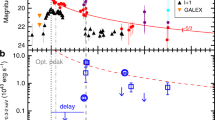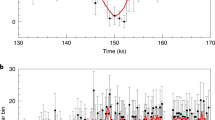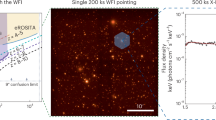Abstract
Published data from X-ray telescopes are not adequate to reveal the fluctuations in the surface brightness of the background radiation caused by clustering or superclustering of the sources giving rise to the background.
This is a preview of subscription content, access via your institution
Access options
Subscribe to this journal
Receive 51 print issues and online access
$199.00 per year
only $3.90 per issue
Buy this article
- Purchase on SpringerLink
- Instant access to full article PDF
Prices may be subject to local taxes which are calculated during checkout
Similar content being viewed by others
References
Silk, J., Space Sci. Rev., 11, 671 (1970).
Brecher, K., and Burbidge, G. R., Comments Astrophys. Space Phys., 2, 75 (1970).
Wolfe, A. M., and Burbidge, G. R., Nature, 228, 1170 (1970).
Schwartz, D. A., Boldt, E. A., Holt, S. S., Serlemitsos, P. J., and Bleach, R. D., Nature Physical Science, 233, 110 (1971).
Neymann, J., Scott, E. L., and Shane, C. D., Astrophys. J., 117, 92 (1952).
Brecher, K., Morrison, P., Phys. Rev. Lett., 23, 802 (1969).
Karachentsev, I. D., Astrofizika, 2, 307 (1966).
Scott, E. L., Shane, C. D., and Swanson, M. D., Astrophys. J., 119, 91 (1954).
Author information
Authors and Affiliations
Rights and permissions
About this article
Cite this article
WEBSTER, A. Can the Lumpy Distribution of Galaxies be Detected by X-ray observations ?. Nature 238, 20–24 (1972). https://doi.org/10.1038/238020a0
Received:
Issue date:
DOI: https://doi.org/10.1038/238020a0



